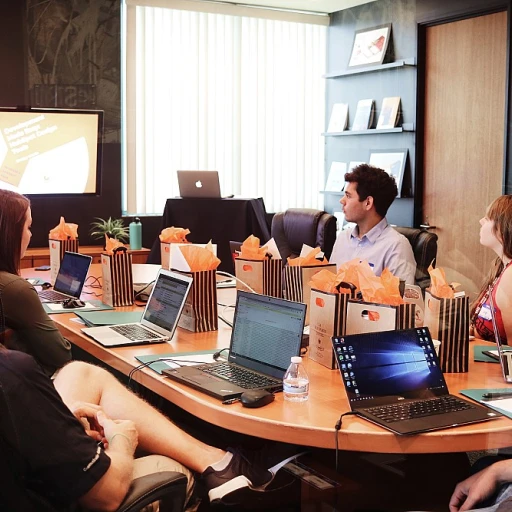
Understanding the Need for Reskilling
The Importance of Reskilling in Today's Business Environment
In the rapidly evolving landscape of the global economy, organizations are increasingly recognizing the necessity of investing in their workforce to achieve high human performance. This need is being driven by several factors, including advancements in technology, shifts in business strategy, and changing work dynamics. One significant response to these challenges is the implementation of reskilling programs, which aim to enhance the competencies of employees for future success.
Human sustainability is at the core of modern management strategies, as leaders strive to ensure their teams are well-equipped with relevant skills. According to research conducted by Deloitte Consulting LLP, there is a growing focus on aligning reskilling initiatives with the needs of the organization to foster efficiency and innovation. Through targeted training, employees can cultivate essential skills that not only improve individual performance but also contribute to better business outcomes.
Moreover, organizations that prioritize reskilling are often better positioned to navigate complex business processes and capitalize on emerging market opportunities. This proactive approach not only supports performance improvement among workers but also contributes to building a resilient workforce capable of adapting to changes in the business environment.
It is crucial for companies to implement strategic people development solutions that address the challenges of reskilling. The successful integration of these initiatives can positively impact human capital and drive performance wellness within the organization. To ensure sustained success, businesses must view reskilling as a continuous journey rather than a one-off initiative. Embracing a learning-driven approach in reskilling can be a key enabler in this process, supporting ongoing individual and organizational growth.
Identifying Key Skills for Future Success
Gearing Up for Future Success
In today's rapidly evolving job market, it is crucial for organizations to identify key skills that will drive future success and enhance human performance. The integration of technology in business processes, changing demands from consumers, and a globalized economy underscore the importance of strategic reskilling efforts.
Organizations are increasingly turning to programs that focus on specific skills essential for future growth. These include expertise in areas like data analysis, digital proficiency, and decision-making capabilities. A forward-thinking organization recognizes that the ability to effectively harness data and adapt to emerging technologies will be paramount in maintaining competitive advantage.
Leaders play a critical role in this effort. They need to foster an environment that encourages continuous learning and supports human capital development. A well-rounded workforce equipped with these key skills will not only improve business outcomes but also contribute positively to organizational agility.
Moreover, Deloitte Consulting highlights the significance of investing in training solutions tailored to future skill requirements. As Deloitte notes, organizations must balance between immediate skill gaps and long-term strategic objectives, ensuring programs address the diverse needs of their workers.
To begin this journey, a solid understanding of current skill levels within the organization is crucial. This can be achieved through applying competency management systems which assess and track employee skills, helping managers pinpoint areas for improvement and growth.
Ultimately, it's about more than just meeting present requirements. The goal is to create a resilient, adaptable workforce that thrives in an era of unpredictability, ensuring sustained excellence in business performance.
Challenges in Implementing Reskilling Programs
Overcoming Common Obstacles in Reskilling Endeavors
Implementing reskilling programs presents its own set of challenges for organizations seeking to enhance human performance. Despite the clear need for reskilling due to evolving technology and business processes, leaders often encounter hurdles that can impede the successful transformation of their workforce. One of the primary challenges lies in securing buy-in from management and the workforce. Organizational leaders must prioritize the alignment of reskilling initiatives with overall business objectives to effectively advocate for training solutions. This alignment ensures that reskilling efforts are seen as a vital investment in human capital rather than a mere operational cost. Additionally, fostering a culture that embraces continuous learning and adapts to change can be complex. By promoting an environment that values human sustainability and performance improvement, organizations can better overcome this barrier. Another significant hurdle is the allocation of resources, including time and financial investments. Reskilling programs require extensive planning and often necessitate substantial credit hours to ensure effective training. Organizations must strategically allocate resources to optimize program outcomes and deliver maximum impact. Leveraging data-driven solutions and performance psychology can significantly enhance decision making, ensuring that reskilling efforts are efficient and impactful. Furthermore, tailoring programs to suit diverse workforce needs is a demanding task. The United States, like many other global regions, comprises a varied workforce with unique skill requirements across different sectors. This diversity necessitates personalized training solutions that respond to the specific demands of workers and operational contexts. By embracing advanced technology and adopting a program that supports these varied needs, organizations can more effectively manage competency and enhance workforce agility. In striving to overcome these challenges, organizations would benefit from incorporating strategies that support human performance improvement and reinforce management’s role in facilitating these transformative programs. Exploring integrated learning systems can also offer substantial benefits in enhancing workforce skills. For more insights on developing and implementing a reskilling initiative, consider exploring enhancing workforce skills with an integrated learning system.Strategies for Successful Reskilling Initiatives
Creating Reskilling Opportunities: Key Strategies for Success
Reskilling is not merely a buzzword, but a necessary process to enhance business outcomes and improve human performance within organizations. To successfully implement reskilling initiatives, it is crucial to adopt well-defined strategies that cater to the evolving needs of the workforce and address the complex challenges faced by businesses today. One of the primary strategies involves leveraging technology to deliver effective training solutions. Organizations can use advanced learning management systems to create tailored training programs that meet the specific needs of their workers. This approach not only facilitates better learning experiences but also supports continuous improvement and adaptability. Organizations must also invest in human capital by encouraging a culture of lifelong learning. This requires integrating successful performance psychology techniques that drive motivation and engagement among employees. Management should create an environment where people feel empowered to take charge of their own learning and development, which in turn enhances their decision-making capabilities and overall job satisfaction. Collaborating with industry leaders such as Deloitte Consulting can provide organizations with the insights needed to design innovative training solutions that align with global trends in human sustainability. By tapping into the expertise of consulting firms, organizations can tailor their reskilling programs to support human performance improvement and optimize business processes holistically. In addition, it is essential for management to engage in data-driven decision making to assess the effectiveness of reskilling programs. Regularly collecting and analyzing performance data will help organizations fine-tune their strategies, ensuring that they meet the dynamic requirements of their workforce and the broader business environment. Organizations must establish well-defined goals and performance metrics to monitor the outcomes of reskilling initiatives. By doing so, they can verify the impact of these programs on workforce agility and overall business performance. Reassessing strategies and continuously iterating upon them ensures that reskilling efforts remain relevant and impactful in a changing world. Ultimately, successful reskilling initiatives consist of a comprehensive approach that synergizes the efforts of technology, human resources, and management. By focusing on these strategic elements, organizations can foster a workforce capable of adapting to future challenges and maintaining a competitive edge in today's rapidly shifting market landscape.Measuring the Impact of Reskilling on Business Performance
Assessing Reskilling's Influence on Business Outcomes
Evaluating the impact of reskilling within organizations often requires considering multiple facets of human performance, business process improvements, and technological advancements. Reskilling programs have shifted focus from mere skill acquisition to encompassing human sustainability and performance enhancement, driving both immediate and long-term business outcomes.
Organizations must prepare to assess these initiatives using comprehensive data analysis and decision making. Reliable data and metrics, as advocated by companies like Deloitte Consulting LLP, play a crucial role in understanding the efficacy of training solutions. This evaluation is not just limited to how well workers acquire new skills but also whether these skills translate into measurable improvements in human and organizational performance.
Key performance indicators (KPIs) should be established to monitor improvements in human capital and workforce efficiency. Consulting global experts has revealed that successful measurement strategies often include a combination of performance psychology and management assessments. Additionally, credit hours devoted to training and development activities can also serve as a tangible metric.
Team leaders play a critical role in facilitating these evaluations. Their on-ground insights into team dynamics and human wellness provide essential feedback on the actual benefits of training initiatives. This feedback loop, capturing insights from human resources, business leaders, and exercise specialists, can refine strategies and align future reskilling programs with broader business goals.
Ultimately, cultivating a culture of continuous learning primes organizations to anticipate and adapt to evolving markets. By embracing dynamic reskilling approaches, businesses not only enhance individual performance improvement but also fortify themselves against future disruptions, setting the stage for sustained growth and success.
The Future of Work: Embracing Continuous Reskilling
The Ever-Converting Landscape of Workforce Expertise
Organizations are increasingly recognizing the value of a perpetually reskilled workforce, especially given the rapid technological advancements reshaping the global business landscape. Continuous reskilling isn't merely about adapting to immediate needs; it's about fostering a resilient human performance that can evolve with shifting demands. As Deloitte Global suggests, aligning human capital efforts with strategic goals ensures that an organization remains competitive.
Business leaders have to acknowledge that the emphasis should be on creating learning systems that support performance improvement over the long-term. It requires deploying training solutions that are agile and responsive to ever-changing business needs. Furthermore, access to sport exercise, multi-disciplinary training, and performance-focused programs can profoundly influence performance wellness.
Establishing Frameworks for Continuous Learning
To successfully incorporate continuous reskilling, organizations need to implement frameworks that integrate human-centric approaches with cutting-edge technology. This includes leveraging data analytics to drive decision making around workforce capabilities and ensuring that the programs support holistic human sustainability.
Moreover, embracing the principles of performance psychology, management can enhance rotations that consistently build upon existing skills while introducing new competencies. A focus on such approaches leads to significant business outcomes by enabling workers to adapt and rise to new challenges confidently.
Encouraging an Adaptive Mindset for Future Growth
For businesses aiming to thrive in the future, fostering an adaptive mindset within their teams is crucial. This involves promoting a culture where continuous learning and development are standard practices. As trends in global human capital indicate, organizations that invest in their human potential are more equipped to navigate uncertainties effectively. Adopting such a mindset prepares the workforce to tackle disruptions head-on and generates a proactive rather than reactive approach to business process evolution.












